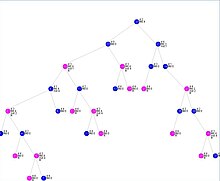Rhizome (philosophy)
This article has multiple issues. Please help improve it or discuss these issues on the talk page. (Learn how and when to remove these template messages)
|
A rhizome is a concept in
As a mode of knowledge and model for society
Deleuze and Guattari use the terms "
Rather than narrativize history and culture, the rhizome presents history and culture as a map or wide array of attractions and influences with no specific origin or genesis, for a "rhizome has no beginning or end; it is always in the middle, between things, interbeing, intermezzo." The planar movement of the rhizome resists chronology and organization, instead favoring a nomadic system of growth and propagation.
In a rhizome, "culture spreads like the surface of a body of water, spreading towards available spaces or trickling downwards towards new spaces through fissures and gaps, eroding what is in its way. The surface can be interrupted and moved, but these disturbances leave no trace, as the water is charged with pressure and potential to always seek its equilibrium, and thereby establish smooth space."[4]
Principles
Deleuze and Guattari introduce A Thousand Plateaus by outlining the concept of the rhizome (quoted from A Thousand Plateaus):
- 1 and 2. Principles of connection and heterogeneity: "...any point of a rhizome can be connected to any other, and must be";[5]
- 3. Principle of multiplicity: it is only when the multiple is effectively treated as a substantive, "multiplicity", that it ceases to have any relation to the One;
- 4. Principle of asignifying rupture: a rhizome may be broken, but it will start up again on one of its old lines, or on new lines;
- 5 and 6. Principles of cartography and decalcomania: a rhizome is not amenable to any structural or generative model; it is a "map and not a tracing". They elaborate in the same section, "What distinguishes the map from the tracing is that it is entirely oriented toward an experimentation in contact with the real."
Arborescent

Arborescent (
Arborescent thinking, to
Rhizomes, on the contrary, mark a horizontal and non-hierarchical conception, where anything may be linked to anything else, with no respect whatsoever for specific
Deleuze also criticizes the
See also
References
- JSTOR 3685805. Retrieved 2022-03-19.
Rhizomatic reading leaps—those leaps between and within texts—are a figure often used to explain hypertext. ... [a] redistributed 'knowledge network' ... If the reader/browser does not understand the content of what he is reading, but is merely organizing it intuitively around criteria based on collective and rhizomatic 'interests,' then the object of research itself becomes a rhizome (growing in one direction due to interest, then drifting off due to lack of interest, all the time growing in multiplicity because of other interests, yet needing a certain stability and stockpiling of information).
- ISBN 978-1-58435-088-0.
[T]he modes of semiotization of an analytic pragmatics will not rely on trees, but on rhizomes (or lattices).
- ISBN 0-8166-1402-4.
- ^ Rhizomes.net
- ISBN 978-1-58435-088-0.
Any point whatsoever on the rhizome will be able to be connected to any other point. ... will not be formalized on the basis of a logical or mathematical metalanguage. ... will be able to allow semiotic chains of all kinds to connect [in addition to linguistic] ... it will imply the implementation of various collective assemblages of enunciation.
- ISBN 0-8264-7694-5.
Sources
- ISBN 0-8264-7694-5.
- ISBN 1-57027-019-8.
- ---. 1996. Soft Subversions. Ed. Sylvère Lotringer. Trans. David L. Sweet and Chet Wiener. Semiotext(e) Foreign Agents Ser. New York: Semiotext(e). ISBN 1-57027-030-9.
External links
- Rhizomes – Cultural Studies Online Journal.
- Power of Networks – RSA Animate video on the "Power of Networks" by Manuel Lima (juxtaposes the tree vs. network approach).
